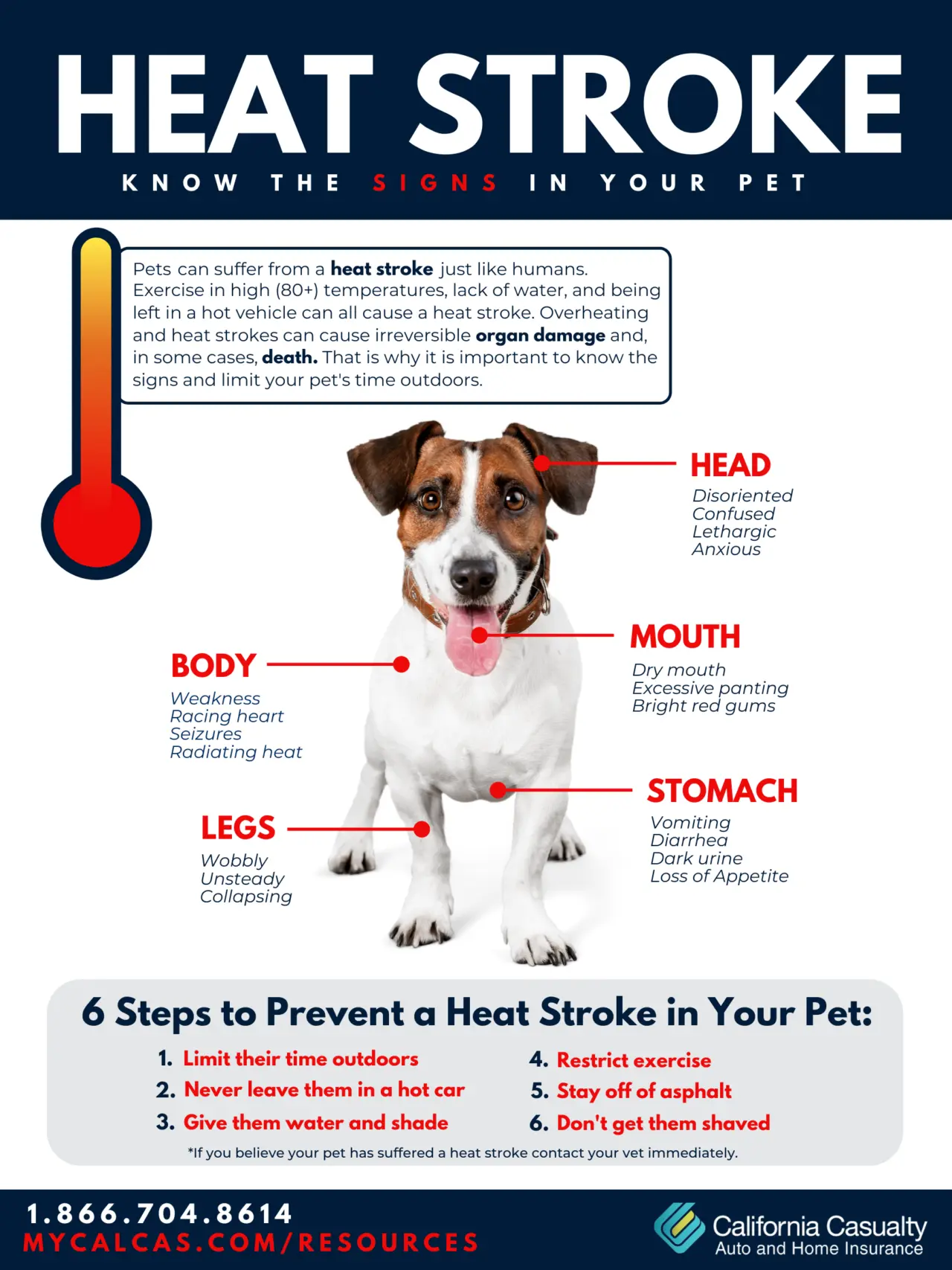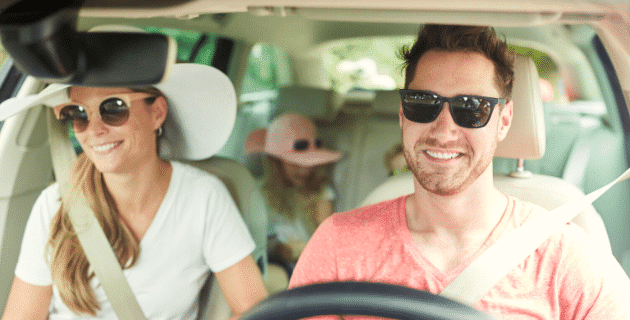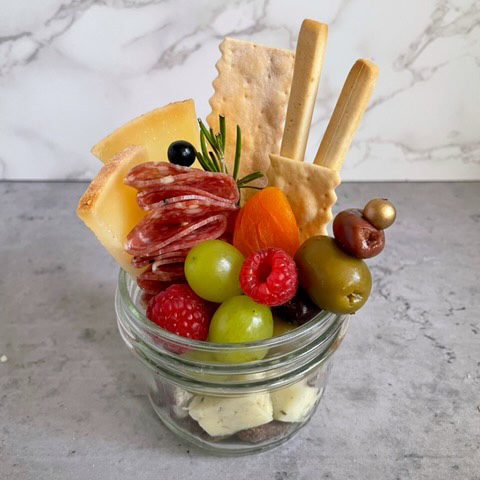
by California Casualty | Pets |
It’s time to go for a w-a-l-k. (Cue the excited wags and barks.) But walking in the summer heat presents some challenges for our fur babies. From hot pavements to high temperatures, conditions can be dangerous for your pup.
Follow these tips to safely walk your dog in the summer heat, including signs to watch out for in case of heatstroke.
Tip #1: Time your walks for the coolest part of the day.
Even when it’s hot outside, there are times of day when it’s a little less hot. Plan around the temperatures, scheduling an early morning walk or an evening stroll. In general, before 9 am and after 6 pm are usually the coolest times.
Tip #2: Bring water along.
Bring a water bottle and a dog bowl to give your dog a drink on hot walks. In addition, consider a spray mist bottle or a wet towel to use to cool your dog down.
Pro Tip: Introduce the bowl and the sprayer at home first with your dog to make sure your pup is comfortable with them.
Tip #3: Seek shade.
Walk in the shade as much as possible and choose a route where you can stop in the shade. Walk on the grass if possible. If not, the concrete sidewalk is generally cooler than the street made from asphalt. If your dog lies down in the cool grass, let him. It’s his way of regulating his temperature.
Tip #4: Check the pavement.
When the temperature is just 86 degrees outside, the pavement can reach a sizzling 135 degrees! That’s way too hot for your pup’s sensitive paws. Before you walk, check the sidewalk or road. Put the back of your hand directly on the pavement. If you can keep it there comfortably for 5-10 seconds, it’s okay to walk. If not, avoid the asphalt and concrete at all costs.
A word about dog boots: You can buy dog boots or paw protectors to protect against hot pavement. Look for non-slip, water-resistant shoes that fit your dog’s paws well and stay on. Also, choose breathable ones. Since dogs do sweat through their paws, that will help keep them comfortable.
Tip #5: Protect against sunburn.
If your dog has a shorter coat or bare spots that can burn, consider dog-friendly sunscreen.
For dogs with long fur, you can give your dog a summer haircut, but don’t shave her to the skin. Dogs need an inch of fur to protect against sunburn.
Tip #6: Know when to turn back.
Your dog will communicate that he has had enough. If he continues to lie down and pant, that’s a signal that the heat is getting to him. Go slowly, and if your dog seems unenthused to walk, don’t push it. Head back and enjoy some air-conditioned indoor time.
Tip #7: Know the signs of burned paws.
Burned paws are painful for our pups. Make sure you check your fur baby’s paws after summer walks. Look for these signs of possible burns:
-
- Limping
- Excessive biting of feet
- Discolored pads, redness or blisters on the paws
Tip #8: Know the signs of heatstroke in dogs.
Heat exhaustion is not just for people. Our pets can get heatstroke, too. In fact, it can be very serious and even deadly. That’s because dogs don’t have sweat glands. Instead, they rely on panting to cool themselves down. When that doesn’t work, the heat builds up in their bodies, causing heatstroke.
Some dogs are more susceptible. These include older dogs, dogs with shorter snouts, obese dogs, and dogs battling illness. Watch for these signs:
-
- Excessive panting and drooling
- Difficulty breathing
- Fever (dog’s nose is dry and hot rather than wet and cool)
- Bright red, gray, purple, or blueish gums
- Rapid pulse
- Weakness
- Vomiting or diarrhea
- Lack of urine
- Muscle tremors
- Dizziness

If your dog exhibits signs of heatstroke or has burns on his or her paws, call your veterinarian immediately. You may be asked to bring your pet in for treatment.
For emergencies like this, pet insurance can help. Remember, you can easily add pet insurance from Pet’s Best to your California Casualty auto or home policy. Find out more about what pet insurance can cover by talking with a California Casualty customer service representative today.
This article is furnished by California Casualty, providing auto and home insurance to educators, law enforcement officers, firefighters, and nurses. Get a quote at 1.866.704.8614 or www.calcas.com.

by California Casualty | Auto Insurance Info |
If you’ve ever been in a car for hours on end, you know the challenges of long-distance driving. It can be uncomfortable, boring, and if you’re tired, even dangerous. Here’s how to stay safe and comfortable during your next long distance road trip.
Plan your route.
Even if you’re using a GPS, you will want to take a look at a map to know where you are going. That allows you to plan your trip, including where to stop to ensure that you’re not driving too long without a break.
-
- Try to take a 15-minute break for every 2 hours of driving.
- Plan your rest stops, not only for mealtimes, but also consider interesting places to visit to break up the trip.
- Account for peak travel times. You may make less progress during rush hours, so consider getting off the road during that time.
Prepare your vehicle.
There’s nothing worse than breaking down on the road for something that could have been prevented with regular maintenance. Before your trip, take a good look at your car, and have it serviced at your local mechanic to make sure it’s in good condition for the trip.
-
- Check fluid levels (brake, coolant, engine oil), tire pressure, and tread depth.
- Make sure that your windshield wipers are in good condition and your lights are working.
- Pack an emergency kit for your car, just in case. This should include safety flares, a flashlight and extra batteries, and a first aid kit.
- Clean and vacuum your car. Sitting in a clutter-free car makes the trip so much nicer.
- Childproof your car before the trip. Make sure it’s safe for your youngest passengers.
Make sure you’re well-rested.
Driving when you’re tired can lead to poor decisions and reduced reaction time which can cause accidents. A study by the AAA Foundation for Traffic Safety estimates that 328,000 crashes each year are caused by drowsy driving. Researchers believe there may be even more than reported. Don’t put yourself or your family at risk.
-
- Get enough sleep the night before your trip, and if possible, the night before that as well.
- Don’t drive when you’re already tired. Avoid planning long drives after work.
- If you feel tired, pull off the road. You can even take a short nap in your car in a safe place, such as a rest stop.
- You can also try short-term pick-me-ups, such as caffeine. Chewing gum can work to keep you awake. Or try an energizing scent. The scent of peppermint can help make you temporarily more alert.
Stay hydrated.
You may be reluctant to drink a lot on your trip, for fear of having to stop more often to go to the bathroom. However, it’s important to stay hydrated. Dehydration can make you feel more tired and cause blurry vision.
-
- Avoid sugary drinks which can cause dehydration.
- Avoid coffee or tea, except as the occasional pick-me-up. They also can dehydrate you.
- Drink water. Pack a cooler and keep it nice and cold so it will feel refreshing.
- You can add citrus or berries to your water for some healthy flavor.
Prepare and plan food and snacks.
Mealtime and snacks are some of the fun of long-distance road trips. Whether you check out a new restaurant or munch on some home-brought favorites, food can be a highlight. Plan for your meals and snacks ahead of time so that you’re not searching for food when you’re hungry, and so that you make the most of your travel time.
-
- Pack sandwiches, put them in a cooler, and then stop for a picnic lunch at a rest stop or park.
- If you have family along the route, stop for a visit around mealtime. You’ll enjoy some homemade food and family time as a bonus.
- Research restaurants along your route. You might find some local fare that you otherwise wouldn’t have a chance to try.
- Choose healthy snacks that keep you full and that aren’t overly messy for the car. These include mixed nuts, trail mix, jerky, granola bars, crackers, carrots, celery, and fresh fruit.
- Bring wipes and designate a trash bag. If you need the floor space for luggage or legs, try a trash container that hangs on the back of the seat.
Stock your car with entertainment.
Long car rides can be boring, and not only for children. Planning things to do can help make the time pass more quickly. If you’re not the one driving, you may even be able to use the downtime productively.
-
- Make a playlist of your favorite songs. Take requests from your (future) passengers and you’ll have everyone engaged.
- Listen to an audiobook or podcast. You can borrow one from your local library or use a favorite streaming service.
- Keep the children occupied with books, puzzles, Mad Libs, Rubberneckers or car games that you can play without any materials, such as I Spy or “find the license plate.”
- Complete a mini-project if you’re not driving, such as organizing your Smartphone screen, deleting photos and emails, brainstorming goals, or practicing a new language.
Finally, make sure you have the proper car insurance. Coverage will give you peace of mind should anything happen on your long distance road trip.
Safe travels.
This article is furnished by California Casualty, providing auto and home insurance to educators, law enforcement officers, firefighters, and nurses. Get a quote at 1.866.704.8614 or www.calcas.com.

by California Casualty | News |
Have you heard about Jarcuterie? It’s a party in a jar—or at least the start of it. If you’re planning an elegant Mother’s Day brunch, a great graduation party, or just a fun get-together, you’ll want to know about this latest craze in entertaining.
What is Jarcuterie exactly?
Jarcuterie is a new twist on Charcuterie boards, traditionally a platter of meats and cheese offered as an appetizer or part of a meal. However, instead of a board or platter, Jarcuterie is served in individual jars. The contents don’t even have to be meat and cheese—in fact, the more creative, the better.
Why is Jarcuterie so popular?
It’s pretty to look at, easy to serve, and you can customize it for your guests’ dietary needs. But the main reason for its growth in popularity is due to the pandemic. Rather than touching a platter that others touch too, you can enjoy this socially distant snack safely. And you’ll feel more comfortable as a host that you are doing your part in keeping everyone healthy and safe.
How do I create a Jarcuterie?
The options are endless, which is why a little forethought and planning will make a difference. Do you want savory or sweet? (Yes, dessert Jarcuterie is a thing!) There are no rules, but keep simplicity in mind; generally, Jarcuterie features small finger food and sometimes dips.
Start with a clear container. Popular choices include a mason jar, plastic cup, or small bowl. Choose a size that’s easy to hold because this snack is portable.
Choose a flavor or theme. An Italian-themed Jarcuterie could feature antipasto ingredients such as meats, cheeses, artichoke hearts, cherry tomatoes, and breadsticks. A Mediterranean Jarcuterie could include fresh vegetables with hummus, olives, and feta cheese. A breakfast Jarcuterie might feature mini-muffins, bacon strips, yogurt, and fresh fruit.
Dips go at the bottom. If you include them, dips are best at the base. That way, guests can dip the items into the bottom without getting their fingers messy.
Include a variety of colors, shapes, and textures. This will create a beautiful display that also balances with its ingredients. Use cookie cutters to make fun shapes out of cheese or other items. Roll meats and cheeses together for a festive look. Keep wet snacks away from crunchy ones or assemble the crunchy ones at the last moment so nothing gets soggy.
Keep height in mind. Display food on skewers or cocktail sticks for varying heights. Vary the items on the skewer such as meat, then cheese. Try 1-2 skewers per jar. Add some tall vegetables like celery, which are great for dipping.
Fill in the gaps with tiny treats. Add nuts, dried fruit, pretzels, or other items to fill in the gaps.
Garnish and decorate. Tie the Jarcuterie glass with a bow. Garnish the food with a fresh herb that goes with the flavor palate.
Still not sure what you’re going to make? We scoured the Internet for some popular Jarcuterie recipes. Here are some of our favorites.
Basic Savory Jarcuterie
Jarcuterie: Cheese Boards in a Jar
This basic Jarcuterie recipe combines meat, cheese, crackers, nuts, fruit, pretzels, and more. It’s kid-friendly and they can even help with the preparation!
Flower Garden Jarcuterie
How to Make a Jarcuterie
This recipe uses broccoli flowers and radish roses to create a beautiful garden on top of a base of peanuts. Switch out the nuts for some salad dressing dip or hummus for a different sping.
Disney Jarcuterie
Disney Jarcuterie
This recipe requires a Disney cookie cutter to create Mickey Mouse ears and any other shape for your child’s favorite character. Definitely a dessert version, this Jarcuterie features M&M candy as the base with fresh fruit and cheese displayed on spears.
Colorful Spring Jarcuterie
10 Simple Spring Grazing Table Food Ideas | La Cucina di Kerrs
For those who like to go over the top, this Jarcuterie comes with suggestions on how to dye your vegetables and even spell out the word, spring, with tiny vegetable cutters.
Sweet Ending Jarcuterie
Sweet Jarcuterie – It’s a Jar Full of Sweets
What’s better than a mason jar filled with your favorite sweets? This dessert Jarcuterie pairs mini marshmallows with chocolate drizzled pretzels and strawberries. You can even add your own candied fruit. Pro Tip: use different colors of chocolate for the drizzle to make your Jarcuterie look extra festive!
DIY Charcuterie Bouquets
https://www.areinventedmom.com/charcuterie-bouquet/
This Jarcuterie isn’t in a jar, but its single-serving paper bouquet wrap has the same idea. Deli meat roses pair with strawberries and herbs for a beautiful presentation.
For more JARcuterie ideas, check out our Pinterest Board, “JARcuterie” and be sure to follow us on Pinterest for every other fun idea we find!
This article is furnished by California Casualty, providing auto and home insurance to educators, law enforcement officers, firefighters, and nurses. Get a quote at 1.866.704.8614 or www.calcas.com.

by California Casualty | Pets |
We love our pets like family, but if we’re being honest, they can be quite expensive. That’s not only in treats, household items, and little splurges but also in veterinary care.
Vet costs can add up quickly, especially if your pet has a health issue or if you have multiple pets. But taking your animal to the veterinarian is an important part of being a responsible pet owner and making sure your pet stays at its healthiest.
Here are some tips to give your fur babies, feathered friends, and reptiles the best care possible without a huge bill.
1. Shop around.
Not every vet charges the same, so it’s a good idea to shop around. Vets in smaller towns may charge less than in more populated urban areas. Call and get costs for exams, vaccinations, and standard procedures such as teeth cleaning, spaying, and neutering. Ask if they give multi-pet discounts if you bring pets in together. You don’t have to choose your vet solely on cost, but keep that in mind when you make your selection.
Pro Tip: Reach out to the local Humane Society or vet school clinic. They may have low-cost options for veterinary care or procedures.
2. Know your vaccines.
Some vaccines like rabies are required by law. Others are optional. Assess whether your pet needs a vaccine based on their potential risk for the illness. For example, if you don’t board your dogs, they may not need Bordetella to protect against contagious kennel cough. But if they’re frequently at the dog park with other dogs, you’ll want them to have it.
Pro Tip: Check with your municipality. They may hold a free rabies shot clinic annually.
3. Research prescription options.
You’ll likely give your fur babies flea and tick medications. You may need to treat your bird or your lizard with an antibiotic. You might need a prescription to calm your pet during a storm. You could get these medications through your vet, or you can get the prescription and shop around. Contact your local (human) pharmacy. If there is a human equivalent to the pet medication, they may be able to fill it for a lower price. You can also enroll in a prescription discount plan like GoodRx or WellRx. Some plans cost but you’ll still realize the savings in discounts.
4. Ask about referrals and specials.
Veterinary offices often run specials. They may discount dental procedures for National Pet Dental Health Month, for example. They may give you a credit for referring a friend. Ask your vet for their schedule of specials and discounts for the year, and plan your pet’s care around that calendar.
5. Don’t automatically say ‘yes’.
Your vet may recommend treatments for your pet. Ask why they’re necessary and what the alternatives are to doing them. Sometimes these recommendations may be precautions but not absolutely necessary. Other times, they may be to rule out issues, but the treatment may be the same. If there is a high cost for treatment, you can hold off and research other places that may be able to provide it at a lower cost. Then take that quote to your vet and ask if they will match the price.
6. Talk to an online vet first.
You can sometimes save on an in-person vet bill by talking to an online vet first. Telemedicine options have increased for veterinary care. For just about $30 or so, you can talk to a vet, have him/her examine your pet virtually, and answer medical questions. For example, if your pet was exposed to a potential household danger, the online vet can let you know if you need to bring your pet in for treatment. Just know that online vets cannot prescribe medication if your pet hasn’t been seen in person by a vet recently.
7. Consider help from a pet charity.
You may qualify for help with your vet bills from an animal welfare charity. These are nonprofit associations that provide assistance for specific types of situations, such as donating wheelchairs for disabled pets, care for cancer treatment, and help for elderly, disabled, or low-income families.
8. Keep up with preventive care.
Nourishing food, regular exercise, and annual vet visits will help keep your pet healthy. Heartworm testing, stool screenings, dental care, parasite control, and bloodwork are all part of regular preventive care. Keeping your pet active and healthy, and checking in regularly on their health, will help reduce vet bills in the future.
9. Purchase Pet Insurance.
Pet Insurance can help offset some of the larger costs of pet care. For a nominal monthly fee, you can have access to coverage that will help if your pet needs surgery or has health issues. Shop around for a pet insurance policy that fits your needs.
Before you purchase, make sure you understand the deductible, the coverage limits, and the exclusions. Some policies do not cover pre-existing conditions or wellness care.
This article is furnished by California Casualty, providing auto and home insurance to educators, law enforcement officers, firefighters, and nurses. Get a quote at 1.866.704.8614 or www.calcas.com.

by California Casualty | Firefighters, Peace Officers |
Ah, the great outdoors. What is it about being out in nature that makes us feel free and more alive?
Not only is camping refreshing, but did you know that it actually has multiple mental health benefits? Read on to learn more about the positive effects of camping—and our special Work Hard/Play Hard Camping Giveaway for First Responders!
1. Camping reduces our stress.
Face it. Even if you love your job, all jobs come with their own stressors, and stress can be harmful to your mental, physical and emotional health. While one camping trip may not completely reduce your stress, you’d be surprised at the impact it can make.
-
- Nature is associated with higher levels of serotonin, a chemical produced by our body that boosts our mood.
- Nature provides a relaxing “soundtrack” that is soothing and peaceful. There’s a reason sleep apps are full of noises from nature. Studies have shown that the babbling of a brook or the sound of wind through the trees promotes relaxation and feelings of well-being.
- From a practical aspect, you can escape the “to do” lists and pressures of work and home. You have less to worry about.
2. Camping provides a digital detox.
As a population in general, we spend too much time indoors in front of our screens. This can lead to mental health issues such as anxiety, depression, lack of focus, and sleep problems. It also can be a contributing factor to obesity. Camping gives us a much-needed break from our digital devices.
-
- Camping allows us to be social. It can promote face-to-face conversations, form bonds, and strengthen relationships.
- It also allows you to be solitary if you prefer, and spend time with your own thoughts. Nature offers the perfect setting for reflection and meditation.
- Unplug during your camping trip. Keep the digital devices to a minimum, set designated phone-free zones, and you’ll enjoy more of what nature has to offer.
3. Camping gives us sunshine and fresh air.
The sunshine and fresh air on your camping trip not only feel good, they have real health benefits. That will make you feel even better about being outside.
-
- If you’re like most Americans, you probably don’t get enough Vitamin D, important for bone growth. Sunshine helps our bodies make Vitamin D, so being outdoors is a natural vitamin boost.
- As you breathe in fresh air, your oxygen levels increase. This helps you to feel more energized. It improves your ability to concentrate and remember.
- Fresh air also can help lower blood pressure, help in digestion and boost your immune system. Enjoy that breath of fresh air. It’s good for you!
4. Camping promotes exercise and resilience.
Camping doesn’t have to be a survival test; you don’t even have to camp in a tent! You can plan your camping trip around your family’s needs and choose enjoyable exercise and favorite recreational activities. This is a chance to try new things and feel good about all you’ve accomplished.
-
- Choose a favorite outdoor hobby or explore a new one. Examples include fishing, biking, hiking, or orienteering (using a map or compass to navigate between points).
- Plan to make your own food over an open campfire, even if it’s just hot water to pour over Ramen noodles. Not only will it be fun, you’ll be building confidence with your newfound skills. Just remember to keep campfire safety in mind.
- If you brought the kids along, this is a great time to teach them personal responsibility.
5. Camping improves sleep patterns.
Because your days and nights will be guided by nature, you’ll escape the light pollution and sleep patterns associated with life back home. And getting an adequate amount of sleep each night has been proven to have a positive impact on your mental health.
-
- The sun emits short-wave blue light in the morning and long-wave reddish-orange light in the evening. This signals our bodies when to sleep and when to wake up.
- Camping allows you to get in touch with your internal clock and natural sleep cycle. A weekend camping trip can move you closer to the ideal sleep-wake time.
- Unlike your normal workday, when you are camping you make your own schedule, meaning you can get rest and wake up whenever you would like. No morning alarms = automatic stress reliever.
- Pro tip: Don’t skimp on sleeping gear. Bring that inflatable mattress for an extra cozy night.
6. Camping brings you home with a new perspective.
You’ll return home with your mind and spirit recharged. You will also appreciate the comforts of home more. Here are just some of the added mental health benefits after a camping trip:
-
- Improved focus, higher levels of confidence, and self-esteem
- Reduced levels of stress and anger
- Stronger family bonds and good memories
California Casualty’s 2022 Work Hard/Play Hard “$10,000 Camping” Giveaway will award one lucky First Responder $10,000 for outdoor gear that lets them disconnect from the daily grind and reconnect with friends, family, and nature.
Firefighters, EMTs, and Law Enforcement officers can enter by clicking here. The deadline to enter is November 18, 2022.
This article is furnished by California Casualty, providing auto and home insurance to educators, law enforcement officers, firefighters, and nurses. Get a quote at 1.866.704.8614 or www.calcas.com.






